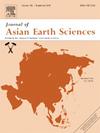Reconstruction of the Late Holocene environments in the northern Minusinsk Basin (South Siberia) based on the palynological analysis of Lake Shira sediments
IF 2.7
3区 地球科学
Q2 GEOSCIENCES, MULTIDISCIPLINARY
引用次数: 0
Abstract
We present the results of a multiproxy study of a 144 cm long core of laminated sediments from Lake Shira in the northern Minusinsk Basin in order to understand the causal relationships between climate change, ecological responses, and hydrological variations. The new palynological record covers the last 2980 years with an average resolution of 21 years. Palynological results and biome scores indicate that steppe and meadow-steppe with sparse forests prevailed in the northern Minusinsk Basin during the Late Holocene. The lower part of the taiga belt in the mountainous frame of the basin was dominated by larch, and the middle part of the taiga belt was dominated by larch, pine, fir, and spruce. The gradually decreasing role of dark conifers indicates a regional trend towards climatic aridification in the Late Holocene. The ratio of Artemisia pollen to Chenopodiaceae pollen suggests that the semiarid climate of the northern Minusinsk Basin during the last 2980 years was repeatedly interrupted by short intervals of more humid climate. The low abundance of Botryococcus in the records from Lake Shira may be an indicator of lowered lake levels during the intervals of lake holomictic state ca. 2850–2800, 2000–1920 BP, 1320–1290 BP, 700–510 BP, and 120–70 BP. Comparison of new environmental records of the northern Minusinsk Basin obtained from Lake Shira with data on global climate fluctuations shows that changes in the regional vegetation and hydroclimate of Lake Shira in the Late Holocene were mainly caused by large-scale atmospheric circulation processes controlling the heat and moisture balance in South Siberia.
基于示拉湖沉积物孢粉学分析的南西伯利亚Minusinsk盆地北部晚全新世环境重建
为了了解气候变化、生态响应和水文变化之间的因果关系,我们对Minusinsk盆地北部的Shira湖的144厘米长的层状沉积物岩心进行了多代理研究。新的孢粉记录覆盖了近2980年,平均分辨率为21年。孢粉学和生物群系分析结果表明,晚全新世Minusinsk盆地北部以疏林草原和草甸草原为主。盆地山地框架针叶林带下部以落叶松为主,中部以落叶松、松、冷杉、云杉为主。暗针叶树的作用逐渐减弱,表明了晚全新世气候干旱化的区域趋势。青蒿科花粉与藜科花粉的比例表明,在过去2980年中,Minusinsk盆地北部的半干旱气候多次被较湿润的短间隔气候所中断。设拉湖记录中Botryococcus的低丰度可能是湖泊整体状态(2850 ~ 2800、2000 ~ 1920、1320 ~ 1290、700 ~ 510、120 ~ 70 BP)期间湖泊水位较低的标志。从谢拉湖获得的Minusinsk盆地北部新环境记录与全球气候波动资料的对比表明,晚全新世谢拉湖区域植被和水文气候的变化主要是由控制南西伯利亚湿热平衡的大尺度大气环流过程引起的。
本文章由计算机程序翻译,如有差异,请以英文原文为准。
求助全文
约1分钟内获得全文
求助全文
来源期刊

Journal of Asian Earth Sciences
地学-地球科学综合
CiteScore
5.90
自引率
10.00%
发文量
324
审稿时长
71 days
期刊介绍:
Journal of Asian Earth Sciences has an open access mirror journal Journal of Asian Earth Sciences: X, sharing the same aims and scope, editorial team, submission system and rigorous peer review.
The Journal of Asian Earth Sciences is an international interdisciplinary journal devoted to all aspects of research related to the solid Earth Sciences of Asia. The Journal publishes high quality, peer-reviewed scientific papers on the regional geology, tectonics, geochemistry and geophysics of Asia. It will be devoted primarily to research papers but short communications relating to new developments of broad interest, reviews and book reviews will also be included. Papers must have international appeal and should present work of more than local significance.
The scope includes deep processes of the Asian continent and its adjacent oceans; seismology and earthquakes; orogeny, magmatism, metamorphism and volcanism; growth, deformation and destruction of the Asian crust; crust-mantle interaction; evolution of life (early life, biostratigraphy, biogeography and mass-extinction); fluids, fluxes and reservoirs of mineral and energy resources; surface processes (weathering, erosion, transport and deposition of sediments) and resulting geomorphology; and the response of the Earth to global climate change as viewed within the Asian continent and surrounding oceans.
 求助内容:
求助内容: 应助结果提醒方式:
应助结果提醒方式:


